What’s going on in the all-terrain crane market?
01 July 2024
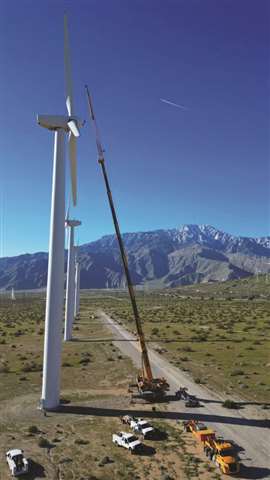 Increasingly, all-terrain cranes are being used for maintenance work at wind farms.
Increasingly, all-terrain cranes are being used for maintenance work at wind farms.
All-terrain cranes perform like all-stars on a range of jobs. Owners praise the cranes because they are mobile, versatile and offer high lifting capacity and long reach. Moreover, they are becoming among the most cost-effective cranes on the market, even though they are expensive and more complicated to operate.
“While AT cranes may have higher upfront costs compared to some other types of cranes, their versatility and performance capabilities offer long-term cost savings for fleets,” said Kameron Krause, general manager of Mr. Crane based in Orange, CA. “They can handle a wide range of tasks without the need for additional equipment, streamlining operations and maximizing efficiency.”
But what about being complicated to operate?
“All-terrain cranes are more sophisticated than the other types of cranes, primarily due to their versatility, the diverse environments they operate and the computer systems/safety enhancements,” said Krause. “There are a few ways that we help to mitigate the learning curve for our all-terrain fleet. We provide comprehensive training on the equipment, ongoing support and mentorship, hands-on experience with a qualified trainer and by emphasizing safety as a top priority.”
It’s the design of an all-terrain crane that wins over owners, Krause said.
■ Mobility: ATs are designed to operate on both rough terrain and highways, offering unmatched mobility compared to other types of cranes, Krause said. “This enables our fleet to access and work in a wide range of job sites, including remote locations and challenging terrain conditions.”
■ Versatility: The ability of AT cranes to navigate various types of terrain makes them versatile assets in a fleet. “They can be deployed across different industries and applications, from construction and infrastructure projects to industrial facilities and emergency response situations,” Krause said.
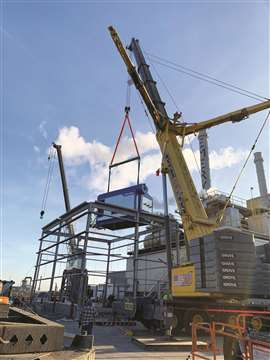 Maxim Crane Works’ Grove AT lifts power equipment.
Maxim Crane Works’ Grove AT lifts power equipment.
■ High lifting capacity: ATs typically have impressive lifting capacities and the ability to handle heavy loads efficiently. “This capability is crucial for lifting and placing large materials, equipment and structures in diverse work environments,” he said.
■ Reach and flexibility: With telescopic booms that can extend to significant heights and reach over obstacles, AT cranes offer flexibility in positioning loads precisely where needed. This flexibility enhances productivity and efficiency on the job site, especially in tight or congested spaces.
■ Quick setup: Despite their size and capabilities, modern AT cranes are designed for quick setup and mobilization. This reduces downtime and allows fleets to respond rapidly to changing project requirements or emergency situations.
Mr. Crane added the first all-terrain crane to its fleet in 1997. Today the company’s ATs range from 40 to up to 500- ton capacities. Primary jobs are bridge girders, tower crane erection/dismantling, light pole erection, transformers, vaults, A/C units, tree lifts, modular homes, steel erection, wind power, battery storage projects and even serving as assist cranes for moving larger crawlers.
Maxim Crane Works, based in Wilder, KY, contends the market for all-terrain cranes is solid, evidenced by the addition of 67 new ATs to its rental fleet over the last 30 months. And the company has even more ATs on order.
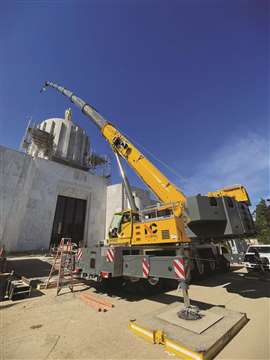 NessCampbell’s Grove GMK5250XL-1 works on a renovation project at the Oregon State Capital Building in Salem, OR.
NessCampbell’s Grove GMK5250XL-1 works on a renovation project at the Oregon State Capital Building in Salem, OR.
“Our best-performing ATs in terms of capacity and size are the 5 and 6 axle machines, which are extremely busy, and our strategically located smaller and larger tonnage classes support clients nationally,” said Maxim’s Greg Bellcoff, vice president of fleet. “Our fleet includes ATs with capacities ranging from 60 to 900 tons, and they primarily handle a mix of commercial building, infrastructure and industrial jobs depending on the region.”
To mitigate the learning curve associated with the sophisticated operation of ATs, Maxim ensures operator and technical training is provided on each new machine. Maxim’s AT fleet includes all four brands produced, Liebherr, Grove, Tadano and Link-Belt.
Long reach
Based in Hillsboro, OR and operating in the Pacific Northwest and western U.S., NessCampbell’s AT fleet ranges from 90 to 600 tons. The company added its first AT in the late 1980s, according President John Anderson. The company uses ATs for all types of jobs, including tilt up work, HVAC replacement, steel erection and industrial plant maintenance.
“The AT brings versatility, high capacity, a long main boom, luffer reach and quick assembly-disassembly,” Anderson said.
In the early years, ATs were considered difficult to operate, but that’s not the case today, Anderson explained.
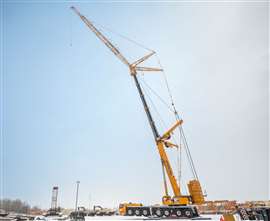 Sterling Crane recently took delivery of the first Tadano AC 7.450-1 in Canada, a seven-axle all-terrain crane with a 500-ton lifting capacity.
Sterling Crane recently took delivery of the first Tadano AC 7.450-1 in Canada, a seven-axle all-terrain crane with a 500-ton lifting capacity.
“I think that in the beginning, this was true, but our operators have adapted and AT training has become a part of our day-to-day training,” he said.
As far as being more expensive, Anderson said they are still profit centers.
“ATs are generally more expensive than a truck crane because of the attachments and the suspension components on the lowers,” he said. “ATs versus crawlers are similar depending on your attachment selections.”
NessCampbell runs several brands of ATs, but Anderson is partial to the Link-Belt ATC-3210.
“Our 5-axle Link-Belt ATC-3210s are hard to beat,” he said. “They have become our day-to-day work horse. ATs have become ‘the primary daily lift crane’ for this industry. It is amazing what the manufacturers are doing with boom lengths and technology advancements with these machines.”
Mr. Crane’s Krause pointed to the safety features of all-terrain cranes.
“ATs are equipped with advanced safety features to ensure safe operation on all types of terrain,” he said. “This includes features such as load moment indicators, outrigger monitoring systems, and operator aids, which help prevent accidents and ensure compliance with safety regulations.”
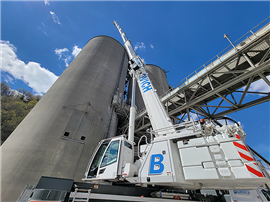 Budrovich Construction’s latest crane is a Liebherr LTM 1110-5.2, the first model in the U.S. equipped with LICCON3.
Budrovich Construction’s latest crane is a Liebherr LTM 1110-5.2, the first model in the U.S. equipped with LICCON3.
Mr. Crane mainly operates Liebherr ATs and a few Grove models he said.
“All-terrains are a niche product and can go many places a truck crane or a crawler can’t make it to,” he said. “They have reduced transportation costs relative to the crawlers and high capacities relative to the amount of support loads required for each configuration. They justify their own value by having reliable lifting and maneuvering capabilities in diverse and challenging environments.”
Strong demand
Out west, Krause said the market for all-terrain cranes in California can be characterized by strong demand for diverse applications with an emphasis on safety and compliance.
As far as the crane that performs the best, Krause points to the Liebherr LTM1400-7.1.
“It’s the largest crane in our fleet that can be utilized in many different applications and configurations,” he said. “This is one of the best 7-axle all-terrain cranes in the market that you can mobilize around California without removing the boom from the machine. We utilize it primarily for wind power, bridge girders and tower crane erection.”

